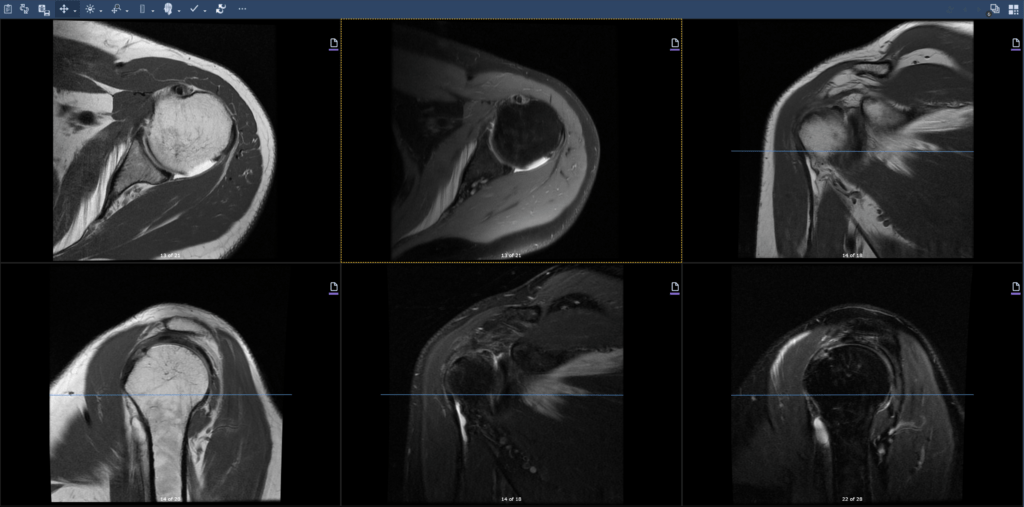This past week has been a pivotal one in my journey toward recovery. After receiving the results of an arthrogram MRI on my left shoulder, I gained a clearer, albeit sobering, understanding of the injuries sustained from last year’s cycling crash.
Unpacking the MRI Findings

The MRI detailed several significant issues:
- Rotator Cuff Damage. The MRI showed a low-grade partial-thickness tear of the supraspinatus tendon, which is one of the four tendons that stabilize the shoulder joint and facilitate lifting the arm. A “partial-thickness tear” means that the tendon is frayed but not completely severed, which can lead to pain and weakness when raising the arm. Additionally, there is moderate partial tearing of the superior fibers of the subscapularis tendon. The subscapularis assists in rotating the arm inward and stabilizing the shoulder; damage here can make rotational movements painful and difficult.
- Biceps Tendon Issues. The MRI revealed a high-grade partial tear of the long head of the biceps tendon. This tendon runs from the shoulder to the elbow, helping to stabilize the shoulder and aid in movements that involve bending the elbow and rotating the forearm. “High-grade” indicates a significant tear, and “partial” suggests that the tendon fibers are extensively damaged but not completely severed. The tear involves the intra-articular segment (within the joint) and the bicipital groove segment (the path the tendon follows along the humerus bone). This kind of injury can lead to sharp pain during arm movements and reduced mobility, severely affecting daily activities that require lifting or rotating the arm.
- Labral Tear. Additionally, there is a tear in the superoposterior labrum. The labrum is a ring of cartilage that surrounds the shoulder socket, helping to stabilize the joint and keep the arm bone securely within the socket. A tear in this area can lead to joint instability, decreased range of motion, and pain, particularly when performing overhead activities or movements that involve lifting the arm.
The Severity and Impact of These Injuries
These injuries are not just painful; they significantly limit my daily activities and have halted my cycling. Each movement can be a reminder of the accident, affecting both my physical capabilities and mental state. Dealing with constant, sometimes severe pain has been a daunting challenge, impacting everything from sleep to simple tasks around the house. Last week, for example, I was unable to load a case of water onto the shopping cart at the store, and I had to ask for help.
The physical limitations have been accompanied by profound emotional repercussions. Being unable to ride my bike and engage in other activities has led to feelings of depression and a loss of focus. This change in lifestyle has not only diminished my physical health but has also affected my mental well-being, creating a cycle of negative emotions and a sense of loss for my previous active lifestyle. Additionally, the inactivity and emotional stress have contributed to weight gain, further affecting my self-esteem and overall outlook on life.
Consultation and Treatment Plan
I met with my doctor on Friday to discuss these results and the best course of action. The recommendation was to avoid surgery and instead pursue aggressive physical therapy as a conservative treatment approach. To aid in managing the pain and facilitate more effective therapy, I received a steroid injection directly into the shoulder joint. This intervention is aimed at reducing inflammation and making physical therapy more tolerable.
I am relieved that surgery is not required at this stage, though the road to recovery through physical therapy will undoubtedly be challenging.
Receiving the MRI results and understanding the exact nature of my injuries has provided a significant emotional lift. Knowing precisely what I am dealing with has allowed me to shift from uncertainty and frustration to a more focused approach to recovery. Having a clear diagnosis and a treatment plan has replaced some of the helplessness with a sense of direction. This clarity has been instrumental in renewing my hope and gradually restoring my motivation to overcome these challenges, step by step.
Moving Forward
As I embark on this rigorous physical therapy regimen, I am cautiously optimistic about regaining some semblance of my former activity levels. I have resumed training in a limited capacity, and I am hopeful that I will be able to return to the Bass Lake Powerhouse Double Century, where I was injured last year, and finish the ride this coming October.
While I do not have a wide circle of support, the encouragement I have received from a few has been meaningful. Thank you to those who have reached out with kind words and support. As I navigate this challenging recovery, I am reminded that perseverance is often forged in solitude, and strength is gained one day at a time. Here’s to better days ahead!

